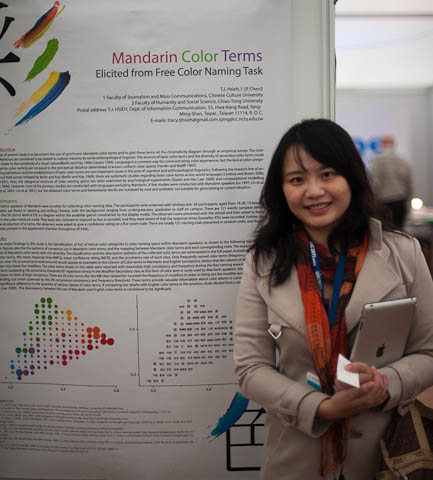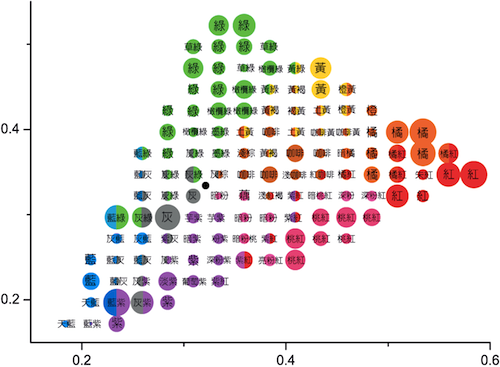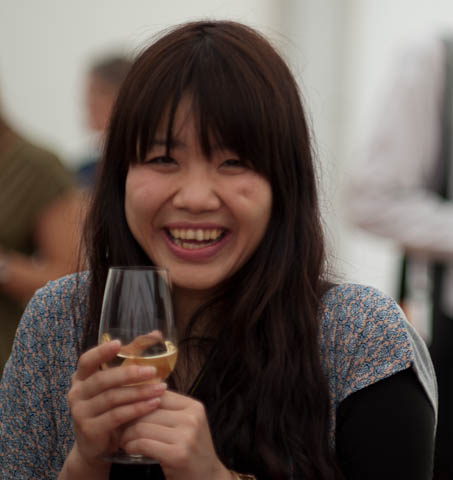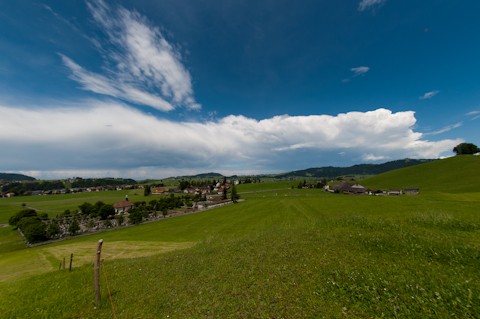For our studies in color naming we have used two kind of experiments to elicit color terms: traditional tightly controlled psychophysics experiments in our laboratory, and crowdsourcing. There is a third kind of experiments, which does not rely neither on our acquaintances nor on our fans on the Internet: paid subjects.
Saturday, December 31, 2011
Tuesday, December 20, 2011
Where did they end up?
Sometimes people are in the news so relentlessly, that we almost think of them as close acquaintances. The American media system is so hyperactive, that except for people who are famous for being famous, these people disappear from the media's radar screen and go back to their normal lives after a short while. However, sometimes they make a career change and end up in unexpected places. I am always surprised by high tech people ending up in epicurean posts.
Monday, December 19, 2011
Need an extra eye?
A natural bioelectrical current jumpstarts normal eye development in frogs, researchers have discovered—suggesting a new route toward repairing damaged or diseased eyes.
Almost all cell membranes have "ion channels" that let charged particles move in and out—the essence of an electrical current. But the first clue that bioelectricity might be critical to eyes came a decade ago when Michael Levin at Tufts University in Medford, Massachusetts, and his colleagues altered the number of ion channels in cells in different parts of a frog embryo and found that lens and retinal tissue formed outside the head. Later work by others showed that cells destined to become eyes had an excessive negative charge.
Levin's team has now verified that these pre-eye cells were hyperpolarized, produced DNA regulatory proteins important for eye formation, and did become a lens and retina. Modifying the function of ion channels in four-cell frog embryos led to eyes in the tail and on the gut, but only where cells experienced a particular voltage range, the researchers reported this week in Development. "Bioelectrical information is both necessary and sufficient for inducing development of the vertebrate eye," comments James Coffman, a developmental biologist at the Mount Desert Island Biological Laboratory in Salisbury Cove, Maine.
Read the full article My, Your Eyes Are So Electric.
Friday, November 18, 2011
color vision challenges in electronic imaging
It has been a long summer and autumn with all interrupts disabled. Now that the product is finished and transferred, we can resurface and catch up with life, which is made easier by doing 脱藩 (dappan).
The SPIE just released a new video explaining how teaching cameras how to "see" as humans do is both an art and a science, and Edwin Land spent his career pursuing that goal. Here is the link: http://spie.org/x83130.xml?ArticleID=x83130
Given the recent events here in Palo Alto, the op-ed linked at the bottom of that page is also a good read.
Wednesday, October 26, 2011
The Colorful Blind Painter

|

|
Turkish painter, Esref Armagan (shown seated in the upper left panel), has been completely blind from the time he was born in 1953. Nonetheless, he has been drawing and painting since childhood. Not only is he able to produce images with the correct shape and perspective—more importantly for readers of this blog—he is able to produce correct colors that he has never seen . The astonishing accuracy of his work is shown here in the other three panels and, as a result, he has held exhibitions in Turkey, Holland and the Czech Republic.
This being the 21st century, naturally his brain has been probed using fMRI and written up in Harvard Medicine:
"As expected, as Armagan drew, the frontal–parietal region of his cortex became active—this area is known to transform perception into two-dimensional imagery and to coordinate sensory–motor information in sighted and nonsighted artists alike. What surprised the researchers was the robust activity in Armagan’s occipital cortex, a region devoted to visual processing."Glad that's all sorted.
Monday, August 29, 2011
Colorful Language
 Eleanor Maclure graduated from BA (Hons) Graphic Design at Nottingham Trent University in 2006 and worked as a graphic designer for a large international architectural practice until the start of 2010. She has studied part time for an MA in graphic design at London College of Communication.
Eleanor Maclure graduated from BA (Hons) Graphic Design at Nottingham Trent University in 2006 and worked as a graphic designer for a large international architectural practice until the start of 2010. She has studied part time for an MA in graphic design at London College of Communication.
Currently she is a postgraduate design student and is doing research about how we communicate color to each other, looking at some of the issues with understanding color names.
Her interest in how people talk about color stems from a range of sources; discussions about re-branding at her previous employer, the way colors are described in fashion trend reporting, and the fact that people have endless disagreements over the color of some objects due to our subjective experiences of color.
Eleanor has a survey that she doing for her research and you can help her by taking part at her survey at this link: https://www.surveymonkey.com/s/T2PCTBK.
Thursday, August 4, 2011
Macallan RPS awards
 The Royal Photographic Society in London has announced the Macallan Royal Photographic Society Awards for 2011.
The Royal Photographic Society in London has announced the Macallan Royal Photographic Society Awards for 2011.
The Progress Medal and Honorary Fellowship, in recognition of an invention, research, publication or other contribution which has resulted in an important advance in the scientific or technological development of photography or imaging in their widest sense, goes to Rodney Shaw, President and cofounder of White Rose Digital, which provides user-friendly imaging-methodologies for digital photographers.
Phil Green, will receive the Davies Medal, which is awarded for a significant contribution in the digital field of imaging science. Instituted in 1998 and sponsored by Kodak European Research and Development, the medal is in memory of Dr. E.R. Davies, a former Research Director of their Harrow Laboratories.
Shaw and Green will receive their awards at the ceremony which will take place on 8 September 2011 at the Royal Society, Carlton House Terrace, London.
Tuesday, July 26, 2011
Color My Mother Chartreuse
 When I was a graduate student in physics, a friend of mine (who was more into art and poetry) invited me over to dinner at his place. While his wife was busy in the kitchen, we were chatting near a window in the late afternoon sunlight. Suddenly, he pointed at a bowl of fruit on a table near the window and asked me why the shadow it cast was colored purple and not black. Looking back on it, I think it was a test—that art vs. science thing. Nonetheless, I was in a profoundly philosophical mood and immediately rejoined: "It's an optical illusion. What's for dinner?" It would be another decade before I would even begin to realize how much I did not understand about color. I had no inkling then that vision and color perception are computational processes, that the brain is a differential analyzer and computed differences carry relative errors (perceptual illusions).
When I was a graduate student in physics, a friend of mine (who was more into art and poetry) invited me over to dinner at his place. While his wife was busy in the kitchen, we were chatting near a window in the late afternoon sunlight. Suddenly, he pointed at a bowl of fruit on a table near the window and asked me why the shadow it cast was colored purple and not black. Looking back on it, I think it was a test—that art vs. science thing. Nonetheless, I was in a profoundly philosophical mood and immediately rejoined: "It's an optical illusion. What's for dinner?" It would be another decade before I would even begin to realize how much I did not understand about color. I had no inkling then that vision and color perception are computational processes, that the brain is a differential analyzer and computed differences carry relative errors (perceptual illusions).More recently, in a faint reprise of that illuminating but ancient episode, I was amazed to learn from Nathan and Giordano that the naming of colors is a similarly profound process, and since they are both experts, I could not be as dismissive with them as I was with my arty friend. On the contrary, I was forced to reflect on how I personally came to learn certain color names. In that landscape, my mother cuts a dominant figure.
Friday, July 22, 2011
Thursday, July 21, 2011
The Pauli Effect
 Spin down
Spin downMy favorite Pauli-effect story has to do with Walter Heitler defending his thesis topic or giving some kind of lecture. After the lecture, Wolfgang Pauli (in typical form) got up on the rostrum and launched into an expansive critique whilst pacing up and down. At some point he was headed towards Heitler, who was by now sitting in a chair at the end of the podium. As Pauli came closer and closer, Heitler leaned further and further back in the chair until he suddenly fell off the end of the stage: at which point some bright spark (possibly George Gamow) called out "Pauli effect!"
Thursday, June 30, 2011
We Call it Brown. They Call It 'Weekend in the Country'
Reader I-Jong L. sent us a pointer to this New York Times article:
We Call it Brown. They Call It 'Weekend in the Country.'
By KATHARINE Q. SEELYE
Published: June 30, 2011
In a redoubled effort to capture consumers' attention, paint companies are hoping to distinguish their brands with names that tell a story, summon a memory or evoke an emotion.
Tuesday, June 28, 2011
Which Path? That Path
A few years ago we (Neil J. Gunther, Edoardo Charbon, Dmitri Boiko, and me) where interested in quantum imaging and experiments confirming Bohr's principle (click the quantum imaging tag in the tag cloud at right). We came up with the concept of photon twinning and understood well how the various order correlation functions relate, which led to a single photon detection camera developed at the University of Delft by Edoardo Charbon, which by postselection can distinguish the photons of its flash light from those of the ambient light (sun).
Monday, June 27, 2011
pre-press is dead
Managers sometimes argue that it is not necessary to attend conferences, because the papers can be read more efficiently in the proceedings. As several post in this blog prove, this is not true, because there are all the discussions in the Q&A periods, breaks, receptions, etc.
One tidbit picked up at the last AIC meeting is that a report will soon appear proving electronic displays are now equivalent to paper in reading efficiency and comfort. It is an easy guess, that in the near future Apple will apply its 326 ppi retina display to the iPad and Samsung will do a corresponding move with its AMOLED based One Cell Touch display OCTA on its Galaxy line. Add E Ink's Triton and it becomes clear that squirting ink on dead trees is a thing of the past. Adobe's latest Creative Suite release is testimony to this shift.
Accordingly, pre-press is a dead word. Please write or say pre-media from now on.
AIC Study Group on the Language of Color (LC)
During the AIC meeting in Zurich, the AIC Study Group on the Language of Color (LC) held a meeting, moderated by the Chair Prof. Jinsook Lee. During the meeting, the delegates discussed two project proposals by Co-Chair Prof. Paul Green-Armytage.
Saturday, June 25, 2011
Jean Gastinel's Memorial Service on 6/26/11
Jean passed away after a sudden tragic accident on 6/8/2011.
Jean's memorial service is on Sunday 6/26/11. The memorial service will be held at:
Valley Presbyterian Church
945 Portola Road
Portola Valley, CA 94028
Sunday, June 26, 2011 2:30 - 4:30 p.m.
Friday, June 24, 2011
Reminder: reduced functionality June 24-26
This blog will have reduced functionality from Friday 24 June 23:00 h UTC to Sunday 26 June 23:00 h UTC due to a scheduled power outage. Two of our name servers and the server with data, applications, and media will receive an UPS (Uninterruptible Power Supply). Only the name server in Europe and text will function normally, as well as the media hosted on external servers.
Thursday, June 23, 2011
EI 2010 color naming paper now open access
Thanks to the generous support of our sponsor, our EI 2010 color naming paper is now open access, i.e., the download is free. The copyright belongs to SPIE: if you have the bits on your server, please remove them and replace them with this link: http://dx.doi.org/10.1117/12.846957. Of course, you can store a copy for personal use on your own computer.
The citation is as follows:
Giordano B. Beretta and Nathan M. Moroney, "Color naming: color scientists do it between Munsell sheets of color", Proc. SPIE 7528, 75280V (2010); doi:10.1117/12.846957
The paper introduces such important concepts as automatic color term translation through colorimetry and crowd-sourcing, as well as the experimental proof that color naming on emissive displays correlates to color naming on reflective media. This paper is also suggests the use of widely available standards such as the Munsell Sheets of Color in order to compare the results of different experiments.
As a reminder, here are the links to our other open access color naming papers:
- Is it turquoise + fuchsia = purple or is it turquoise + fuchsia = blue? http://dx.doi.org/10.1117/12.872581
- Toward Robust Categorical Color Perception http://www.hpl.hp.com/techreports/2009/HPL-2009-146.html
- Cognitive Aspects of Color http://www.hpl.hp.com/techreports/2008/HPL-2008-109.html
Next time you purchase a printer, please consider one of our sponsor's fine printers: http://h10010.www1.hp.com/wwpc/us/en/sm/WF02a/18972-18972-3328065.html
Tuesday, June 21, 2011
Mandarin color terms elicited from free color naming task

At the AIC 2011 meeting, Tsuei-Ju Hsieh from the Chinese Culture University presented the poster Mandarin color terms elicited from free color naming task she prepared with I-Ping Chen of the Chiao-Tung University.
Up to now, there have been only few color naming experiments in Mandarin and their behavioral results are outdated. Tsuei-Ju Hsieh enrolled 36 native Mandarin speakers and asked them to freely name 121 evenly sampled stimuli sweeping the 50 cd/m2 level of the 1931 CIE chromaticity diagram. The response times were also recorded and following the production of a name, the observers were asked to give a confidence rating on a five-point scale.
The result is the identification of the foci of lexical color categories in a color naming space within Mandarin speakers, as shown in the figure below:

There is significant difference in the quantity of various classes of color terms when comparing Tsuei-Ju Hsieh's results with the English color terms in a previous study elicited from a similar task.
A full journal paper is about to appear in Color Research and Applications.
Monday, June 20, 2011
Color naming experiment using 2D and 3D rendered samples

At the AIC 2011 meeting, Midori Tanaka presented the paper Color naming experiment using 2D and 3D rendered samplesColor naming experiment using 2D and 3D rendered samples she wrote with Shoji Tominaga and Takahiko Horiuchi, all of Chiba University.
Usually in color naming experiments the observer is shown color swatches and asked to provide a color term for each swatch. In Tanaka's psychophysics experiments the observers were shown a single color swatch and then asked to assign to it one of the 15 basic Japanese color terms (the 11 universal plus turquoise, chartreuse, gold, and silver).
While usually the color swatch is completely uniform, i.e., the pixels all have the same identical RGB values, Tanaka chose a different rendering in each experiment. They were 2D (i.e., identical RGB values), 3D rendering with low contrast shading, 3D with high contrast shading, and 3D with shading and specular reflection:

An unexpected result is that observer determine the color term significantly faster with the 3D sample than with the 2D sample. Unfortunately this does not lead to a methodology for faster color naming. Indeed, the main result of the paper is that the number of bright color terms decreases in the case of 3D samples, so the data from 3D samples cannot be compared directly with data from 2D samples.
Not unexpected is that orange and brown change in opposite directions from 2D to 3D. This paper is clearly the beginning of research to much better understand the mechanisms of color naming in the human visual system.
Midori Tanaka will graduate from her master course next March and she still has to decide whether to pursue a Ph.D. or find employment in industry. If you can provide her with an active role in your organization, please let her know.
Tuesday, June 14, 2011
Reduced functionality June 24-26
Friday, June 10, 2011
Color semiotics
Color semiotics: everyone is talking about it these days, but where can we find a certain rule or framework which defines it? What parameters are involved? Is this framework useful for designers? Can it be communicated? Can its variation be modelled?
Meet Maryam M. Darrodi, who is trying to answer all of these questions in her Ph.D. research under supervision of Professor Stephen Westland in the University of Leeds.
But there is a part for you too. You can join her Global Online Survey about Colour Semiotics in your very own native language and answer a few questions about a certain color by just clicking on this link: https://www.keysurvey.co.uk/survey/365495/1a02/.
This survey takes less than 3 minutes and you can participate as many times as you wish (each time you will be presented with a different color).
For more information visit http://coloursemiotics.wordpress.com/.
Wednesday, June 8, 2011
validating large-scale lexical color resources
Midori Tanaka has just finished her presentation on a color naming experiment using 2d and 3d rendered samples and we are starting our presentation on validating large-scale lexical color resources. Here are the slides:
Tuesday, June 7, 2011
AIC 2011 Reception

The Midterm Meeting of the International Colour Association (AIC) at the Zurich University of the Arts is in full swing. Here are some pictures from the reception:


















Sunday, June 5, 2011
The Milky Way to AIC 2011

If you visit the European headquarters of the Mostly Color Channel (MCC), just a short 10 minute train ride with the Südostbahn (SOB) up the mountain takes you to Einsiedeln, which translates to hermitage.

Although Einsiedeln's lush landscape today consists of fat fields on which cows graze, filling the air with the tolling of their bells, in the year 835 when the hermit monk Meinrad from Reichenau settled here, it was a dense forest.

If you walk up to the St. Benedikt vista point shown above, you will have a beautiful view of the monastery. The original Benedictine monastery was built in 934, but the building you see today is the sixth replacement, whose construction began in 1704.

As the towers suggest, this is the view from behind. One of the tricks the architect liked to play, was that of perspective. What is the difference between the image above and the one below? 85 mm vs. 66 mm focal length and about 960 m vs. 939 m elevation.

Anyway, many people do not approach the abbey by SOB but on foot, because their motivation is not MCC but a spiritual journey. Indeed, Einsiedeln is one of the major monasteries on the Milky Way, or Jakobsweg as it is called here.
Milky Way is the old Roman name, when this was a trading route, because it followed the Milky Way to the Atlantic Ocean. Today is has become in fashion again and is often called by its Castillian name of El Camino de Santiago. The branch through Einsiedeln feeds from Austria and Milano and has an unusual feature in that it crosses the lake of Zurich with a footbridge just a meter or so above the water. From the bridge from Rapperswil to Hurdensteg, which is at 410 m, you climb straight up the mountain to cross the Etzel Pass at the chapel of St. Meinrad, which is at 950 m, and enjoy this view as you approach the monastery towards the Baroque and Rokoko abbey church (Klosterkirche):

Given this physical exertion, it is no wonder in front of the esplanade the pilgrims find the Lady Fountain (Marienbrunnen or Frauenbrunnen or Liebfrauenbrunnen) where they can enjoy some fresh alpine spring water.

The importance of the monastery becomes clear from all the gold used in its decorations.

Looking up the abbey, the building is quite imposing, which is very surprising considering we are in a small alpine village distant from the metropoles.

Ora et labora governs the day of the Benedictine monk, hence there are innumerable clocks and other time pieces everywhere.

The pilgrims are welcomed in front of the main door in a serious but warm atmosphere.

In general, the natives are quite friendly and do not mind posing for a tired wayfarer from half a world away, made poorer every day from the relentlessly dropping Dollar.

The most well known native of Einsiedeln was Paracelsus (1493–1541), the inventor of modern medicine and pharmacology. For now, let us get ready to sway from the Milky Way and make a detour to the original goal: the Midterm Meeting of the International Colour Association (AIC) at the Zurich University of the Arts.
Wednesday, June 1, 2011
Mrs. Gisler's garden
A year has past since we wrote about the gardens of Mrs. Stine and Mrs. Nonaka. As the AIC Color 2011 midterm meeting date approaches, we slowly approach the venue, and what is better than exploring the local gardens?
Although last year's gardens had Japanese roots, they showed the clear signs of California's punishing arid climate. In Zurich, the climate is almost as moist as in Japan, so we can expect a comparable lushness. Today we visit Mrs. Gisler's garden:

The many tones of green are perfect, without any trace of blemishes from a scorching sun and deprivation of moisture in the air. At the moment it is raining and the brilliant green of the leaves is further accentuated.

Yellow flowers too:

Yellow? What is that yellow man-made object in the distance? Is it trying to compete with the flowers?

It is a small yellow table in front of a fancy metallic bench. Its perfect smooth geometry contrasts with nature's fractals.

Step back. Are we in gamut?

Let us check from closer:

From the bench, beyond the yellow table, we look on a small pond.


Despite the loud colors, it is very quiet here. The only sounds are distant, from up the ridge, were near Johanna Spyri's birthplace (immortalized in Heidi) the cows and goats graze, the bells tolling at their each step.

In the pond, the fish are busy eating the mosquitos floating on the still pond.



 STS-135 re-entry as seen from the ISS [Source:
STS-135 re-entry as seen from the ISS [Source:


